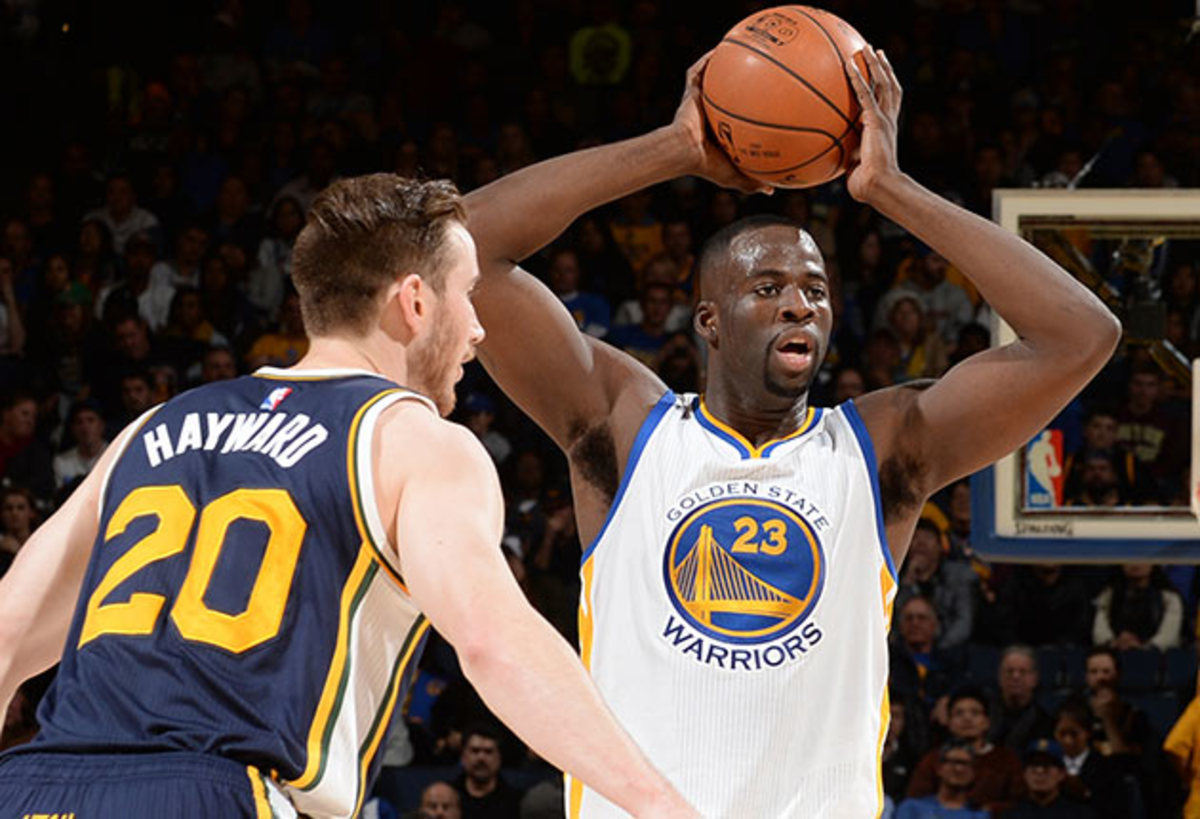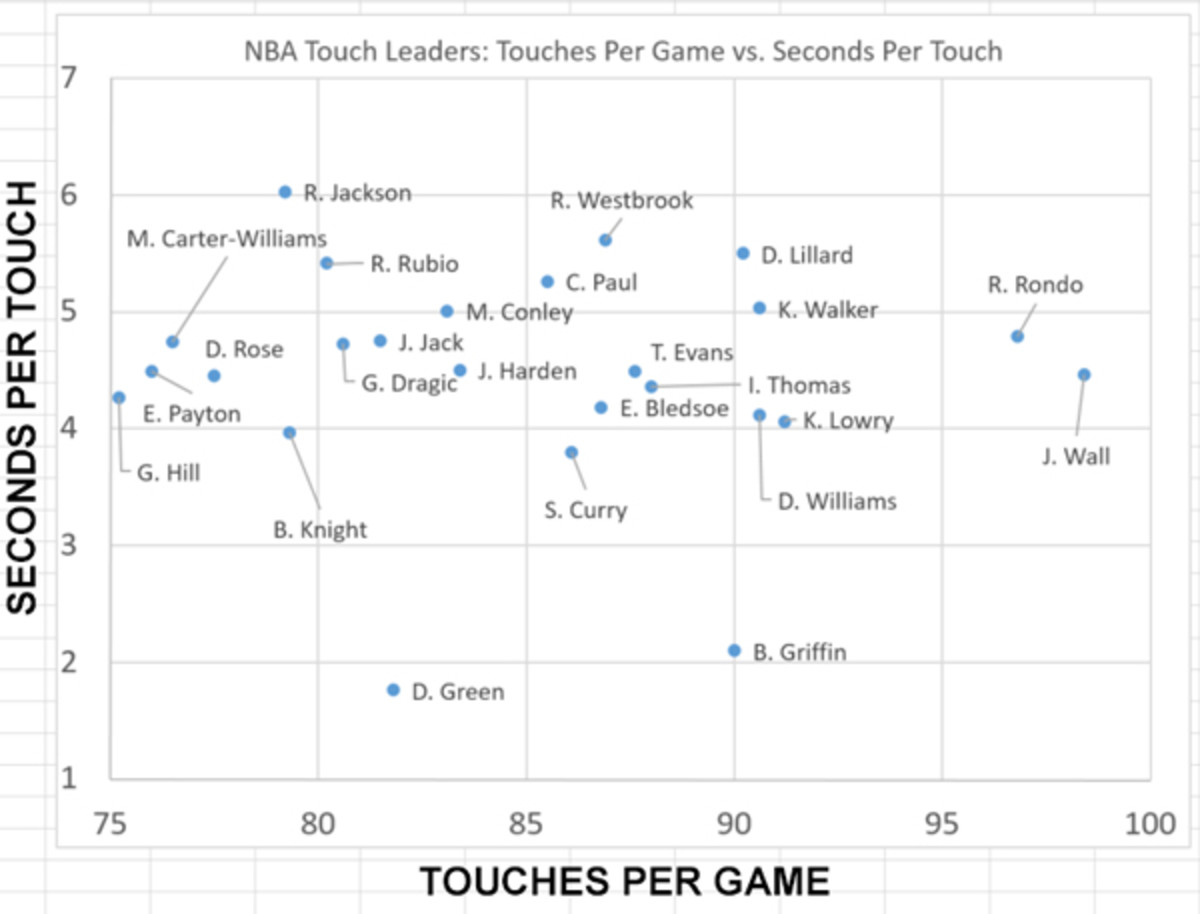What can't he do? Draymond Green's skills put him in a category of his own

Imagine, for a moment, the following Jeopardy! category with the heading, “NBA Players.”
• For $200: He leads the defending champion Warriors in assists and passes per game, topping Stephen Curry in both categories.
• For $400: He leads the NBA in triple doubles, surpassing Rajon Rondo and Russell Westbrook.
• For $600: He leads all forwards and centers in total touches, besting Blake Griffin and LeBron James.
• For $800: He is the first player to average nine rebounds and seven assists in the same season since Grant Hill in 1997.
• For $1,000: He can be described by all of the following terms: undersized center, elite rim-protector, point forward, stretch forward, 2016 Most Improved Player candidate, 2016 Defensive Player of the Year candidate, 2016 All-NBA First Team candidate, 2016 All-Defensive First Team candidate, and surefire first-time All-Star in 2016.
Who is Draymond Green? Correct. Who is Draymond Green? Correct. Who is Draymond Green? Correct. Who is Draymond Green? Correct. Who is Draymond Green? Correct.
The preceding setup was an elaborate way of making a simple point: the 6'7" Green has been in a category all his own this season.
As valuable as he was to the Warriors’ 2015 title pursuit, Green has taken a significant step forward in 2015–16, posting career-highs across the board (15 PPG, 9.5 RPG, 7.5 APG) and absorbing extra responsibilities as a play-maker. Those developments paid off with the first Player of the Week award of his four-year career Monday; Hours later, Green celebrated by delivering his third consecutive triple double in a blowout win over the Hornets.
• 2015 IN REVIEW: Best stories | Top moments | Craziest events | Sneakers
SI.com ranked Green No. 16 on our most recent Top 100 ranking last August, a decision that raised some eyebrows and objections. With the benefit of the last few months as hindsight, Green was clearly underrated and fully deserving of a top-10 spot. He currently ranks No. 4 in Real Plus Minus and No. 8 in Win Shares, and the Warriors boast a spectacular +20.6 net rating when he’s on the court. Curry is still Golden State’s best and most important player, but there are 20+ teams, at this moment, without a player as skilled, influential, reliable and complete as Green.
Need more convincing? His 15/9/7 averages have only been matched by seven players: Hall of Famers Wilt Chamberlain, Magic Johnson, Larry Bird, Oscar Robertson, and John Havlicek, plus the aforementioned Hill and Fat Lever. This is special territory: it’s just not that common that someone can be a reliable scorer, a very productive rebounder, and a proficient playmaker at the same time.
That last part has been the biggest step forward for Green this season, and it’s worth a full exploration.
Green playing more, doing more
Green’s role as a passer has been a true evolution, one that isn’t simply explained by his increased role. Just as Green’s assist rate has increased dramatically in each of the past two seasons, so too have his touches. The following chart, which relies on Sport VU data, shows how Green’s assist numbers and touch numbers have outpaced his increase in minutes.

He’s not just playing more. He’s doing more every minute that he’s on the court. In 2013–14, when Green was still backing up David Lee for coach Mark Jackson, he was touching the ball about as often every game as typical fourth or fifth options like Wesley Johnson and Marvin Williams. Last season, in a starting role under coach Steve Kerr, Green touched the ball as often as skilled All-Star big men like Marc Gasol and Chris Bosh. This year, under interim coach Luke Walton, Green is touching the ball every game nearly as often as ball-dominant, All-NBA caliber guards like Chris Paul and James Harden. That is a serious, serious come-up.

Green making quick decisions
What’s so pleasant about Green, specifically, and the Warriors, in general, is that the ball doesn’t stick. This chart, with data from Sport VU, shows the top 25 players in terms of touches per game compared to how long they hold the ball every time they get it.

NBA Power Rankings: Bulls, Clippers rise up ranks, but will they fall again?
Green’s best comparison point is Clippers forward Blake Griffin, another do-everything forward who is the only other frontcourt player currently in the top 25 for touches per game. As you would expect, both Griffin and Green use significantly less time each time they touch the ball than their backcourt counterparts: they aren’t bringing the ball up the court and they’re rarely pounding away on the perimeter.
The takeaway here is that Green is making lots and lots of quick decisions, often split-second ones. Indeed, each of his touches uses less than two seconds and he is averaging just 1.1 dribbles every time he touches the ball. There’s just no time being wasted.
Green being utilized brilliantly
Green’s ping-ping quick passes have become a foundational element of Golden State’s No. 1 ranked offense. Let’s go through some examples.
2016 NBA New Year’s resolutions for every team in the Western Conference
First, the term “stretch forward” doesn’t fully explain Green’s offensive role. While he is comfortable roaming the perimeter and shooting from beyond the arc, he’s often in position to attack an exposed defense when he receives a pass near the top of the key. Green has options in these scenarios: he can drive to the hoop, attempt one of his favorite runners, drive-and-kick to a shooter, or look for an alley-oop target over the top. All of those options consistently produce points for the Warriors. They have plenty of brands of poison available for purchase by their opponents.
Here’s the standard “bang-bang” look. Curry draws two defenders and Green attacks the third defender, thereby creating a wide open corner three for Ian Clark. Note that Green uses just one dribble and very little time to make this play. Note also that he does it on the move and in control. Body control is a major component in his assist creation.
Here’s a similar look. Curry again pulls out two defenders, Green proceeds to attack the defense in a 4-on-3 in the open space, and he tosses a lob over the top to Andrew Bogut once he’s pulled Bogut’s man away from the basket with his own threat to score. Again, Green needs only one dribble and very little time to pick apart the defense and generate a very high percentage basket.
[youtube:https://youtu.be/Wo28mXv2mBo]
Here’s another similar look, although this time Green receives the pass from a double-teamed Curry in traffic. The natural responses for many big men in this situation would be to panic, to reset as quickly as possible, or to put the ball on the court in hopes of generating offense for themselves in a one-on-one scenario. Instead, Green turns calmly, surveys briefly like a point guard, and finds a cutting Klay Thompson for an uncontested dunk. He doesn’t use a single dribble for this assist.
Here, Green takes the pass from Curry, who has drawn two defenders, and heads straight into a 4-on-3 scenario. It takes Green just one dribble to pull a defender his direction and find a seam for an easy dunk for Andre Iguodala.
On all of these plays, Golden State makes use of Curry’s shooting and playmaking abilities to set up Green as the focal point. Once the ball is in his hands, Green puts his natural understanding of spacing, his quick-thinking and his creative passing to work.
Green is just really good at passing
Green’s natural instincts and ability as a passer shouldn’t be undersold.
This clip might be the least “impressive” of the clips presented, because the defense is so poor, but it’s a good example of two Green strengths: pushing the ball in transition and putting his passes to Curry and Thompson on the money for catch-and-shoot looks. Green uses just two dribbles to rapidly bring the ball into the frontcourt before spying Thompson for an open three. Thompson catches and fires easily in one motion. The shot is off with 21 seconds remaining on the play clock! After a made basket!
Here Green reads the chessboard beautifully and instantaneously, corralling a somewhat slow skip pass from Iguodala and immediately rifling a pass to a cutting Ian Clark inside for a lay-up (that’s goaltended). Green appears to have recognized that Dwight Howard was caught out of position on the strong side before he has even received the pass and then waited a beat for Clark to clear the only weakside defender before tossing what might be considered a somewhat risky pass for many players. For Green, it’s child’s play.
This last one sees Green unselfishly pass up his own good shot for a great shot. Thompson attacks the paint, draws three defenders and then passes out to a wide open Green at the top of the arc. Green suckers a defender into closing out on him with a pump fake before using one dribble to drive into the heart of the defender. He’s already a full step ahead by this point: Thompson has retreated to the right corner and Green finds him on the money for a catch-and-shoot three.
Note that Green is shooting a blistering 40.9% on above-the-break threes this year. Thompson, however, is knocking down a ridiculous 45.9% from the right corner. Perhaps it’s more accurate to say, then, that Green passed up a great shot for a really great shot.
This is skill, high IQ, and a pass-first mentality—all rolled into one. If your point guard makes this play, you’re thrilled. If your four or five makes this play, you’re the world champs.
Green is fairly careful
Without a doubt, Green takes some chances. He’s an ultra-confident player who isn’t afraid to squeeze a pass between multiple defenders, toss up a lob on the run, or push the ball hard in transition in search of an edge. Those types of plays come with a clear potential cost—turnovers—that often cause coaches to adopt a more cautious approach.
Year In Splash: Stephen Curry's most memorable performances from 2015
Golden State knows the pros and cons of this trade-off better than anybody. The Warriors play fast and free, and they are a bottom-10 team in turnover percentage this season. So far that hasn’t really come back to bite them: Their league-best 32–2 record and their league–best 111.9 offensive rating are convincing evidence of that fact.
Green’s ability to protect the rock helps a lot. Entering Monday’s action, his 2.5 assist-to-turnover ratio was better than All-Star point guards like John Wall (2.3), Jeff Teague (2.2), Russell Westbrook (2.2) and Damian Lillard (1.9). He fares even better when compared to other heavily-involved frontcourt players like Blake Griffin (2.1), LeBron James (1.7), Marc Gasol (1.6) and Paul Millsap (1.5), in part because passing is generally a higher priority than looking for his own offense, which would naturally lead to a lot of turnovers.
Put it all together—the involvement, the use of space, the passing ability, the unselfishness, the raw intelligence, and the general care for the ball—and it’s clear that Green has emerged this season as an incredibly refined weapon.
